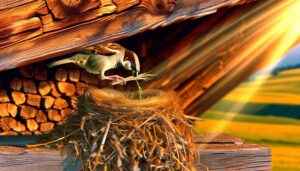Are Cotton Balls Good for Sparrows Nest? A Guide
Using cotton balls in sparrows’ nests has both advantages and significant drawbacks. Cotton balls offer improved insulation, help maintain stable temperatures, and reduce physical stress on hatchlings.
However, they can also pose serious risks. Cotton retains moisture, potentially leading to mold growth and health hazards.
It can entangle chicks, causing injury or death, and lacks structural integrity, leading to nest collapses. Safer alternatives include wool, feathers, and coconut fibers which provide insulation, durability, and mold resistance.
Create a sparrow-friendly environment by supplying straw, grass, and feathers alongside safe habitats with pesticide-free gardening. Find out more details in our full discussion.

Key Takeaways
- Cotton balls can improve insulation but may entangle and harm sparrow chicks.
- Cotton balls retain moisture, leading to mold growth and potential health hazards.
- Cotton lacks structural integrity, causing nest instability and possible collapse.
- Natural materials like straw, grass, and feathers are safer and more durable for nests.
- Alternatives such as wool and coconut fibers offer insulation and mold resistance without entanglement risks.
7 Aspects: Are Cotton Balls Safe for Sparrows’ Nests
| Aspect | Details |
|---|---|
| Naturalness | Cotton balls are not a natural material for sparrows, and they may not instinctively choose them. |
| Breathability | Cotton balls are dense and may restrict airflow in the nest, leading to potential issues with moisture buildup. |
| Moisture Retention | Cotton can hold moisture, which may lead to mold or bacteria growth in the nest, making it unsafe for chicks. |
| Comfort | Cotton is soft and might seem comfortable, but its compact nature can create problems if it gets too wet. |
| Safety | Loose fibers from cotton balls can entangle sparrows or their chicks, leading to injury. |
| Better Alternatives | Natural materials like grasses, twigs, feathers, and animal fur are safer and preferred by sparrows. |
| Use in Captivity | In controlled environments, sterilized cotton may be used cautiously but should be monitored closely. |
Benefits of Cotton Balls

Over time, using cotton balls in sparrows’ nests has shown several benefits, including improved insulation and comfort for the birds.
By providing an additional layer of warmth, cotton balls help maintain a stable temperature within the nest. This stability is essential during colder seasons, as it enhances the survival rate of sparrow chicks.
In addition, cotton balls offer a soft and cushioned environment, reducing physical stress on hatchlings. You’ll notice that this also promotes more frequent breeding, as sparrows seek out ideal nesting conditions.
Moreover, cotton balls are lightweight and easy for sparrows to incorporate into their nests, facilitating quicker nest construction.
Risks of Using Cotton Balls
Including cotton balls in sparrows’ nests presents several risks that could potentially outweigh their benefits. Cotton fibers can entangle chicks, leading to injury or even death. Additionally, cotton balls retain moisture, creating a damp environment that fosters mold growth, posing health hazards to the birds. You must also consider that cotton balls lack the structural integrity necessary for a sturdy nest, resulting in instability and potential nest collapse.
| Risk | Consequence |
|---|---|
| Entanglement | Injury or death of chicks |
| Moisture retention | Mold growth and health hazards |
| Lack of structural integrity | Nest instability and collapse |
Natural Nesting Materials
Why not consider the advantages of natural nesting materials that can provide sparrows with safer, more effective alternatives to cotton balls?
Natural materials are inherently designed to meet the needs of wild birds, ensuring their nests are both durable and breathable.
Here are four key benefits:
- Breathability: Natural fibers like grass and straw allow for adequate air circulation.
- Temperature Regulation: These materials help maintain a stable nest temperature.
- Durability: Natural materials are more resistant to wear and tear.
- Safety: They reduce the risk of entanglement and ingestion-related injuries.
Safe Alternatives to Cotton
Given the potential risks associated with cotton balls, exploring safe alternatives like wool, feathers, and coconut fibers can greatly enhance the well-being of sparrows.
Wool provides excellent insulation and is biodegradable, making it an ideal nesting material.
Feathers are another great option as they offer natural warmth and comfort, resembling the sparrows’ natural habitat.
Coconut fibers, known for their durability and resistance to mold, can provide structural integrity to the nest while maintaining breathability.
By opting for these safe alternatives, you can guarantee that sparrows have access to materials that support their health and nesting success.
This approach not only benefits the birds but also contributes to a more sustainable and eco-friendly environment.
Tips for Helping Sparrows

To effectively support sparrows, provide a consistent supply of fresh water, especially during dry spells. This simple step guarantees they stay hydrated and healthy.
Additionally, you can enhance their environment by offering suitable nesting materials and safe habitats. Consider these actionable tips:
- Install Birdhouses: Place sparrow-specific birdhouses in your garden to provide secure nesting sites.
- Provide Natural Materials: Supply natural fibers like straw, grass, and feathers instead of cotton balls to support their nesting needs.
- Create a Safe Habitat: Plant native shrubs and trees to offer shelter and food sources.
- Avoid Pesticides: Use organic gardening methods to guarantee their food sources are free from harmful chemicals.
Conclusion
To sum up, while cotton balls might seem like a cozy option for sparrows’ nests, they can be a double-edged sword. Natural materials like twigs and grasses are safer and healthier.
Think of it as choosing whole foods over processed snacks. Opt for safe alternatives like pet hair or straw to support sparrows effectively. Your thoughtful choices can make a tangible difference in their well-being.
Keep nature’s balance in mind as you assist these charming birds.






